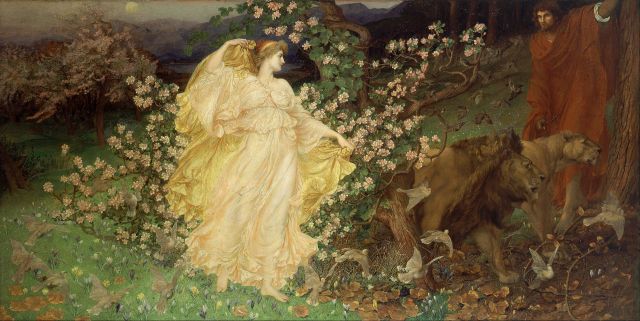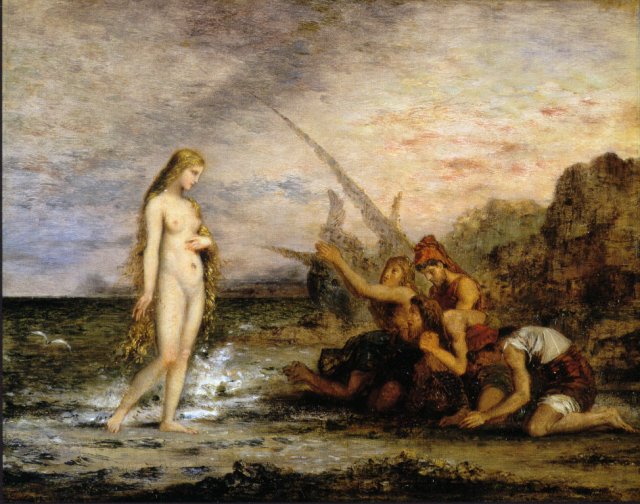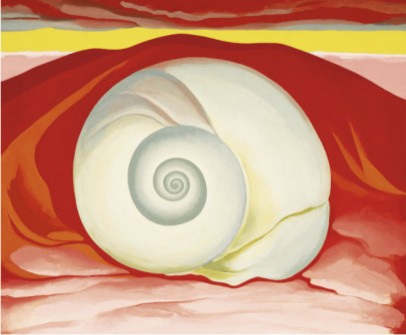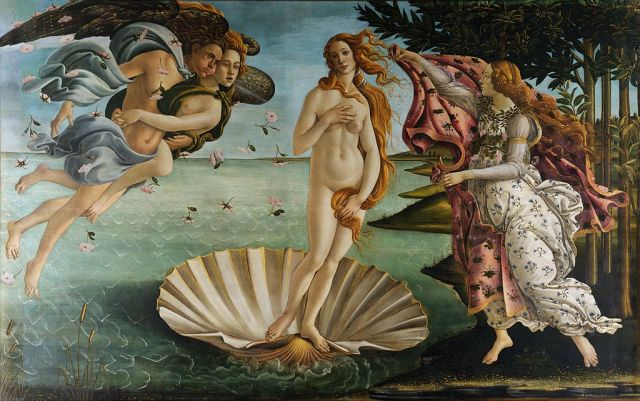If our exact time of place and birth is like a lodestar to interpreting our qualities and our destiny, it must make a lot of sense to look closely at the birth of Venus and relate what we find to her archetypal significance. She has a most extraordinary birth tale, after all. At the beginning of time, the sky god Uranus and the earth goddess Gaia were locked in never ending lovemaking. Yet there was no happiness, for she was groaning under the oppression of constant pregnancies as Uranus chased all the offspring back into her womb. In desperation, she gave a white sickle to her son Kronos, who castrated his father and threw his testicles into the sea:
“Earth took into herself the bloody drops that rained down. Within a year she gave birth to the powerful Erinyes, the Furies. … From the immortal flesh that fell into the surging sea there arose in time a white froth, or aphros. Inside the foam was nurtured a lovely girl. First she floated toward holy Kythera, and then to Cyprus pounded by the sea. Out she stepped from the waves, a queenly beautiful goddess, and around her slender feet fresh grass sprouted.” (Martin)
“Circles formed on the surface of the water, and one of them was edged with white foam. From the middle rose Aphrodite, together with her first serving maids, Apate and Zelos, Deceit and Rivalry.” (Calasso)
Dissecting the myth, which Liz Greene is particularly good at, it is worth pointing out that Kronos is “not an independent masculine principle, but rather the masculine side of the generative principle over which the Mother presides.” He is associated with the yearly ritual of king sacrifice, whose purpose was to “fertilise the earth and renew the crops.” Right at the beginning, as it appears, the principle of Aphrodite/Venus and the principle of fertility go hand in hand. Other Venusian principles in plain sight would be: conflict, strife, violence, which eventually beget breathtaking beauty and harmony. Furthermore, Aphrodite seems to combine celestial and terrestrial aspects in her archetypal make-up: she has the Uranian disembodied, abstract aestheticism and perfection coupled with an equally strong chthonic, carnal and sensual aspect. By standing up against the father, the titan Kronos made a necessary step in his individuation process. When the principle of Venus is activated, families may get shattered, which will awaken the Furies (Erinyes). There is blood and suffering at the core of Beauty, it seems.
As progeny of a primordial god, Aphrodite is older than the Olympians. She has enormous generative power at her disposal, and is a solar (the Golden One) rather than lunar deity. As Venus she competes in her brightness with the sun. Sworder remarks:
“…the phallus of the sky god is the sun and the saw toothed stone which Cronus takes to it is the jagged ridge of the western horizon, and the very moment of excision is that lovely moment as the sun sinks slowly out of sight beneath the world’s edge. Then the western sky is reddened by bloody member till in the midst of it appears the Evening Star.
…
For as star she is seen to stand above the sun after he has sunk beneath the western horizon, as she stands above him before he rises in the east.”
By the same token, Friedrich, quoted by Greene talks of her “sunlit sexuality” – she unashamed, usually portrayed nude, as opposed to other more modest goddesses. Her incarnation is fully blownl: she openly chooses mortal men as lovers, and does not punish their desires as Artemis or Hera did. Liz Greene quotes Paul Friedrich:
“The drives of sexuality are natural; on the other hand, sophisticated love-making is highly cultural. Aphrodite mediates between the two, ‘puts them together’. Or, better, she does not make them identical but interrelates them and makes them overlap to a high degree. To put it yet another way, we can agree that she is a ‘goddess of rapture’ but ought to recognise that this rapture harmoniously blends natural and cultural ingredients.”

William Blake Richmond, “Venus and Anchises”
“Yet in turn Aphrodite laughed at them and boasted of how she had driven gods to mate with women, but never herself had wanted a mortal’s bed. Zeus decided he’d change that. He filled Aphrodite with sweet longing for Anchises, who lived in the rugged uplands of Mt. Ida near Troy. He was a handsome young man with a common trade: herding cattle. One day she was sitting on Olympus, assured of her powers, smugly looking over the world, when she noticed him. That was all it took. Aphrodite instantly began to feel the pangs of desire for this unsuspecting youth. She hurried to Paphos and her temple there, filled with the scent of cypress. She gently closed the shining doors of the inner chamber and undressed, bathed luxuriantly, then clothed herself (with the help of the Graces) in a gown permeated with the most alluring perfumes. Then she rushed north toward Troy, striding high above the clouds, until she set herself down on Mt. Ida. The place was well known as “mother of beasts,” and as soon as she set foot there, they came out to greet her. Gray wolves that fawned at her feet, lions with glaring eyes, bears, leopards. Aphrodite was delighted seeing them, and by her very presence she infused them with the joyous urge to love. Two by two the animals went to lie and mate in the shadowy woods.”
Richard P. Martin
Uranian blood shedding finds its reflection in the two most typical Venusian symbols – the apple and the rose. They are united by the sensual symbolism of the color red. In this connection, Sworder offers his own take on the symbolism of the birth of Aphrodite:
“Red are our lips and nipples and our most private parts, reddest when closest to the consummation of love. Then they distend and bloom with the redness of blood. This is the blood shed by Cronus when he castrates his father Uranus and the phallus falls into the sea. The phallus is the sun which froths and colors the white cloud and the star of the goddess appear standing over its redness.”
Among its many significations, an apple seems to bring to mind the infamous “apple of discord.” Love can bring harmony and satisfaction of desire, but just as often it causes misery, jealousy, rivalry and all sorts of destructive passions. Roberto Calasso ingeniously links Aphrodite with Ananke – the goddess of necessity. While Ananke, together with Kronos, symbolizes the precision of karmic laws, with their austerity and relentlessness, Aphrodite seems to embody “a rebellion of lightness.” To quote Calasso with his uncanny precision:
“Olympus is a rebellion of lightness against the precision of the law, which at that time was referred to as pondus et mensura, “weight and measure.” A vain rebellion, but divine. Kronos’s chains become Hephaestus’s golden web. The gods know that the two imprisoning nets are the same; what has changed is the aesthetic appearance. And it is on this that life on Olympus is based. Of the two, they prefer to submit to Eros rather than Ananke, even though they know that Eros is just a dazzling cover for Ananke. And cover in the literal sense: Ananke’s inflexible bond, which tightens in a great circle around the world, is covered by a speckled belt, which we see in the sky as the Milky Way. But we can also see it, in perfect miniature, on the body of Aphrodite when the goddess wears her ‘many-hued, embroidered girdle in which all charms and spells reside: tenderness and desire are there, and softly whispered words, the seduction that has stolen the intellect even from those of sound mind.’ Unraveled across the darkness of the sky, that belt denotes not deceit but the splendor of the world. Worn by Aphrodite, the girdle becomes both splendor and deceit. But perhaps this was precisely what the Olympians wanted: that a soft, deceiving sash should cover the inflexible bond of necessity.”
Our Venusian encounters are sealed with fatedness. Lightness quickly and imperceptibly becomes heaviness. Consequences weigh on lovers with Ananke’s unforgiveness.

The cycle of Venus, Detail from James Ferguson’s, Astronomy Explained Upon Sir Isaac Newton’s Principles, 1799 ed., plate III, opp. p. 67, via http://freemasonry.bcy.ca/anti-masonry/venus.html
In astrological symbolism, Venus relates to the golden ratio – the measurable aspect of beauty. Nobody has expressed the beauty of the birth of Venus in a more outstanding fashion than Rilke in his poem “The Birth of Venus,” in Edward Snow’s translation:
“In the morning after that night which fearfully
has passed in outcry, tumult, uproar,—
the sea split open once again and screamed.
And as the scream slowly closed again
and from the sky’s pale light and brightness fell back into the mute fishes’ chasm—:
the sea gave birth.
From first sun the hair-froth shimmered
on the wide curl of wave, on whose lip
the girl stood—white, wet, confused.
As a blade of new green leaf stirs,
stretches, uncoils itself and slowly opens,
her body unfolded into cool sea-air
and into untouched early morning breeze.
Like moons the knees rose brightly
and ducked into the cloud rims of the thighs;
the calves’ slender shadows retreated,
the feet flexed and grew luminous,
and the joints came alive like the throats
of drinkers.
And in the hips’ chalice lay the belly,
like a young fruit in a child’s hand.
Within its navel’s narrow cup was all
the darkness that this bright life contained.
Beneath it the small wave rose lightly
and lapped continuously toward the loins,
where now and then there was a silent ripple.
But translucent and yet without shadow,
like a birch stand in early April,
warm, empty, and unhidden, lay the sex.
Now the shoulders’ quick scales stood already
in perfect balance on the upright body,
which rose from the pelvis like a fountain
and fell hesitantly in the long arms
and more swiftly in the hairs’ cascades.
Then very slowly the face went past:
out of downtilted darkness
into clear, horizontal upliftedness.
And behind it the sharp closing of the chin.
Now, with the neck stretched like a ray of light,
and like flower-stalks in which the sap rises,
the arms too stretched out like necks
of swans, when they are searching for the shore.
Then into this body’s dark dawning
came the first breath like morning wind.
In the vein-trees’ tenderest branches
a whispering arose, and the blood began
rushing louder over its deep places.
And this wind increased; now it plunged
with all its might into the newborn breasts
and filled them and crowded into them,-
so that like sails full of distance
they drove the light girl toward the shore.
And thus the goddess landed.
Behind her,
as she strode swiftly on through the young shores,
all morning the flowers and the grasses
sprang up, warm, confused,
as from embracing. And she walked and ran.
But at noon, in the heaviest hour,
the sea rose up once more and threw
a dolphin on that selfsame spot.
Dead, red, and open.”
References:
Roberto Calasso, Marriage of Cadmus and Harmony, Kindle edition
Liz Greene, The Astrology of Fate, Kindle edition
Richard P. Martin, Myths of the Ancient Greeks, Kindle edition
Reiner Maria Rilke, New Poems, Kindle edition
Roger Sworder, Science and Religion in Archaic Greece: Homer on Immortality and Parmenides at Delphi, Kindle edition
















I have a very beautiful young niece. Tall, masses of blonde ringlets, rosy mouth who is very good surfer. To see her run out of the surf, surfboard under her arm, is to always picture a happy Aphrodite, beloved by dolphins. Thank-you!
LikeLiked by 1 person
Sounds lovely.
LikeLike
Breath-taking. Literally. We are blessed with you work, Monika.
LikeLiked by 1 person
Thank you so much, dear Donna.
LikeLike
Reblogged this on lampmagician.
LikeLike
Wonderful post, Monika. I feel like I gain new insight every time I read one of your posts. Sending blessings your way.
Jeff
LikeLiked by 1 person
Thanks, Jeff. Always so great to hear from you.
LikeLiked by 1 person
Yeah. My new job has been really challenging mentally. Haven’t had the energy to spend as much time in blog-land as I used to, but I am always happy to read one of your posts 🙂
LikeLiked by 1 person
I love seeing patterns in Nature, and I like what I read from the planet Venus and the pentagram:
“One would get a pentagram by picking any sunrise date on which the morning star is prominent and then repeating the observation at 584 day intervals following that date.”
I also love seeing the patterns in flowers, so the supposed “myth of Orchis” haunted me when I started photographing Orchids, so I researched it, but didn’t find much, just two links:
http://www.ancientworlds.net/aw/Post/1262724
and
http://www.ancientworlds.net/aw/Post/1262725
Suggesting the “Orchis” name was used at the time. According to the links above, “Orchis”, was believed to be a satyr. Orchids were also known as “Satyrions”, from their connection to satyrs. It was believed that orchids were the food of the satyrs, and incited them to excesses. Also, in Greek mythology, Orchis was the son of a nymph and a satyr. During a celebratory feast for Bacchus, Orchis committed the sacrilege of attempting to rape a Maenad priestess, resulting in his being torn apart by wild beasts, then metamorphosing into a slender and modest plant (the orchid).
In yet another version of the Greek myth of Orchis, he happened upon a festival of Dionysios in the forest, drank too much wine and tried to rape a Maenad priestess. The Maenads took insult and tore him apart. When his father prayed for his restoration, the gods transformed him into a flower. From his death arose Orchids which are a testament to the male reproductive organs (the testis). “The last piece of the beautiful young godling to be disposed of was his masculinity, which was tossed into the sea. From the union of Orchis and the foaming waves, Aphrodite was born. She stepped out of the ocean near Paphos (which derives its name from Paphinia, another Greek name for Aphrodite), and wherever she walked, flowers grew”. Yet, this myth is very obscure, and reading your essay now I realise there are other sources that are more reliable. I simply became involved because I love Orchids. What do you think of this Orchis account?
I’m so glad that through you I met Dewin Nefol. He really helped me pull out an even more interesting post with his questions. He’s writing some beautiful metaphysical poems.
LikeLiked by 1 person
Fascinating.
I am also fascinated by the Golden Section and patterns in nature. This article really captured me recently: https://wegoastrology.wordpress.com/2015/07/20/the-cycle-of-venus-retrograde/
I had never heard about the myth of Orchis. I like this version a lot too because it links Aphrodite with Dionysus. They were lovers, too.
Finally, about Dewin – I think he is a fascinating writer.
Thank you, as always.
Monika
LikeLike
Thanks for the link! Here’s the link to the post I wrote more than a year ago, Aquileana helped me a little with finding the name of Theophrastus (c. 371 – c. 287 BC), who was the Greek botanist who coined Greek word “Orkhis (genitive orkheos)” referring to the flower:
https://tropicalfloweringzone.wordpress.com/2014/05/07/dendrobiums-orchids/
I have a feeling this myth may have developed later, but you’ve read so much more than me on this matter.
LikeLiked by 1 person
Thank you for all the links! They really do belong in this post. What an amazing planet this is. Just about to go retrograde. I honored her with an altar today.
Best wishes for the cycle to you
In gratitude
Monika
LikeLike
Thank you Monika!
LikeLike
Monika, thanks so much for the link. I understand when she says:
“The celestial mandala that Venus’ retrograde loops perform illustrates its inherent beauty perfectly. The center of the mandala is Earth, the place where one must struggle to achieve wholeness and knowledge. Quinary symbolism traditionally represents man after the fall, in his profane Pandemic state. Esoteric schools see the power of the number five as the cause, not the effect, of the five-digit contact points on our human extremities” Such an interesting article, and reveals Newton’s interest in this area, looking closer at the diagram you published, I found this;
(via https://johncarlosbaez.wordpress.com/2014/01/04/the-pentagram-of-venus/)
The Net, in alchemy, is an alloy of copper and iron, whose crystal structure induces a network pattern on its surface. It was described in the 17th century by the Cambridge-educated scientist Sir Isaac Newton. Newton produced the substance by following what he regarded as a recipe, encoded in classical mythology, for part of the process of achieving the philosopher’s stone. The relevant myth involved the god Vulcan finding his wife Venus (alchemical symbol for copper) in bed with the god Mars (alchemical symbol for iron)
Look at this one:
“Newton was fascinated by Starkey’s encoded laboratory processes, extracting and interpreting them many times throughout his manuscripts. Like Starkey, Newton believed that ancient Greek and Roman mythology contained hidden alchemical secrets. For example, the story (found in Ovid’s Metamorphoses) that the gods Venus and Mars, locked in an illicit embrace, were trapped in a bronze net by Venus’s husband Vulcan was interpreted as an allegory for making an alloy of copper and star-regulus that Starkey called “the Net.” Alchemists traditionally used planetary names for the metals, naming lead Saturn, iron Mars, tin Jupiter, gold Sol, copper Venus, quicksilver Mercury, and silver Luna, so it is easy to see how a fable concerning Venus and Mars could be seen as a chemical recipe.”-
http://www.pbs.org/wgbh/nova/physics/newton-alchemy.html
LikeLiked by 1 person
Ok, here it is:
(image by John Carlos Baez via a https://johncarlosbaez.wordpress.com/2014/01/04/the-pentagram-of-venus/)
LikeLiked by 1 person
This works much better, as the other files didn’t. Remember this view is assuming you are standing on earth in the centre, so even if the sun is moving here. This is called the ancient “geocentric” model in astronomy, a description of the cosmos where Earth is at the orbital center of all celestial bodies. This video shows the orbit of Venus around the earth over the course of about 8 years, which is how long it takes to complete an entire pentagram.
LikeLiked by 1 person
This is one is seen with the sun in the middle with the Heliocentric model, in which the Earth and planets revolve around the Sun at the center of the Solar System.
For a real neat website, please look here:
http://www.gci.org.uk/animations/ThreeDifferentOrbits_2.swf
LikeLiked by 1 person